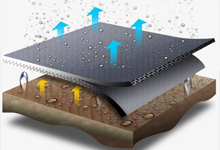Development status and suggestions of functional meta-aramid fiber technology
Functional meta-aramidTechnological development status and suggestions
Abstract: This paper expounds the current development status of functional meta-aramid technology such as colored, conductive, high flame retardant, and nanometer, outlines the preparation methods, performance characteristics, advantages and disadvantages of each functional meta-aramid, and puts forward suggestions for future development. It is pointed out that slow industrialization progress, insufficient industrial chain development and incomplete product standards are problems that need to be solved urgently in the development of functional meta-aramid fiber technology. It is recommended to cooperate with upstream and downstream industry, academia and research institutions as soon as possible to develop functional meta-aramid fibers with good performance and high stability, and to establish relevant product standards as soon as possible.

Keywords: functional meta-aramid; technology development; current situation; suggestions
0 Introduction
Meta-aramid, that is, poly-m-phenylene isophthalamide fiber, commonly known as aramid 1313, is a high-functional fiber material with high thermal stability, outstanding flame retardancy and good electrical insulation.
Meta-aramid was first successfully industrialized by DuPont in the United States in the 1960s, with the trade name Nomex®. In 1972, Teijin of Japan began producing meta-aramid fiber under the trade name Conex®. In 2004, Yantai Taihe New Materials Co., Ltd. successfully developed my country’s meta-aramid fiber and industrialized it. The trade name is Tameda®, and its current production capacity reaches 7,000 t/a.
Meta-aramid is mainly produced through the polymerization of isophthaloyl chloride and meta-phenylenediamine. Its preparation principle is:
Meta-aramid molecules are linear macromolecules composed of phenylene groups connected to each other by amide groups, and their crystals belong to the triclinic system. In its crystal structure, hydrogen bonds exist on two benzene ring planes, arranged in a lattice-like manner, thus forming a three-dimensional structure of hydrogen bridges. Due to the strong hydrogen bonding in the crystal, its chemical structure is stable, which gives meta-aramid fiber superior heat resistance, flame retardancy and chemical corrosion resistance, so it is widely used in industrial filtration, protective clothing and national defense industry, etc. field.
With the rapid development and widespread application of the meta-aramid industry at home and abroad, market demand has tended to be diversified. Among them, functional meta-aramid products have received more and more attention.
Functional meta-aramid fiber is based on the manufacturing technology of white meta-aramid fiber, through modification of fiber molecular structure or addition of additives, etc., to make the product have special functions such as easy dyeing, easy conductivity, flame retardancy, etc., so as to meet the needs of Different application markets have special needs for meta-aramid fibers.

1 Current status of technological development
1.1 Colored meta-aramid
Under normal circumstances, meta-aramid appears white in appearance and has metallic luster. However, in application fields such as protection and flame retardancy, the fiber needs to be dyed into colorful products to better meet people’s needs for aesthetics and comfort. . Therefore, colored meta-aramid fibers came into being.
At present, there are two main ways to prepare colored meta-aramid fiber. One is to color the original solution and then spin to produce colored meta-aramid fiber; the other is to modify the meta-aramid fiber to add a certain amount of color to the molecular structure. Meta-aramid products are produced by adding easily dyeable groups and then post-dying them.
1.1.1 Liquid-dyed meta-aramid
The basic process of preparing liquid-colored meta-aramid fiber is as follows: pretreatment, color matching, and dispersion of appropriate colorants to prepare the coloring stock solution, then adding it to the meta-aramid polymerization stock solution, spinning, coagulation, and drying , crimping, heat stretching and other processes to produce colored meta-aramid fiber.
The advantages of preparing colored meta-aramid fiber by dope dyeing are short process, good color fastness and low cost. The disadvantage is that the color is not easy to control, and changes in process parameters or stretch degree have a greater impact on the final color depth. The finished fabric is difficult to post-process.
At present, among domestic enterprises, Yantai Taihe New Materials Co., Ltd. has realized the industrial production of liquid-dyed meta-aramid fiber. Its products have a high degree of serialization and complete varieties, and can fully realize customized production models according to customer needs.
1.1.2 Post-dyed meta-aramid
When processing fabrics made of colored fibers made from dope dyeing, it is easy to cause discoloration of the fabric. At the same time, when blended with other colored fibers, due to the color difference between colored meta-aramid fibers and colored fibers, it is easy to cause There is a color difference problem in the product. Therefore, the development of post-dyed meta-aramid technology is very important.
However, due to the meta-aramid structure, the fiber macromolecules have a tight structure, a large degree of crystallinity, and no affinity groups, making it difficult for dye molecules to enter. Therefore, when dyeing using conventional dyeing methods, the dye uptake rate of the fiber is very low. . Therefore, high temperature and high pressure are usually used to modify the fiber before dyeing to improve the dyeing effect. Common meta-aramid modification methods include fiber surface modification and molecular structure modification
By physically and chemically modifying the fiber surface, the post-dyeing effect of meta-aramid can be improved. Common surface pretreatment methods include radiation pretreatment dyeing, liquid ammonia or oxygen pretreatment, plasma pretreatment dyeing method, etc.; molecular structure modification, that is, by changing the type or proportion of raw materials for preparing meta-aramid fiber, the meta-aramid fiber is modified. The molecular structure of aramid fiber is modified. It improves the post-dyeing effect of fibers��The strength retention rate is as high as 87%, which is double the anti-aging performance of aramid without anti-aging treatment, showing better UV resistance and anti-aging properties. The advantage of this method is that it has better UV resistance, but the disadvantage is that the protective layer will fall off during use, causing the loss of UV resistance of the fiber. Another method is to evenly add anti-UV additives to the meta-aramid fiber when manufacturing the fiber, so that the meta-aramid fiber has good UV resistance and anti-aging properties from the inside to the outside. For example, Xing Zhe et al. added benzophenones, triazines or benzotriazole ultraviolet absorbers into the meta-aramid polymerization solution. After the meta-aramid was irradiated with ultraviolet rays, its breaking strength, The properties such as elongation at break and initial modulus are significantly higher than those of products without additives.
1.4 High flame retardant meta-aramid
Since meta-aramid is an inherently flame-retardant fiber with a limiting oxygen index (LOI value) ≥ 28%, it will not spontaneously ignite, melt or produce droplets in the air under normal circumstances. But when encountering extremely high temperatures, the fibers will rapidly expand and carbonize. Therefore, appropriately improving the flame retardancy of meta-aramid fiber to achieve higher flame retardant properties is of great significance for the use of meta-aramid fiber products.
There are usually two methods to improve the flame retardancy of meta-aramid fiber. One is to use appropriate reagents to effectively treat the fiber surface to improve its flame retardancy. For example, after treatment of meta-aramid with hexabromocyclohexane, its flame retardant properties are significantly improved; second, by adding polymerized monomers to change the molecular structure of the fiber, its flame retardant properties are improved. For example, when chlorine element or aromatic sulfone group is introduced into the molecule, the heat resistance and flame retardancy of meta-aramid fiber are significantly improved.
1.5 nanometer meta-aramid
Nanofibers refer to fibers with a diameter of nanometer scale, or fibers modified by filling nanoparticles into the fibers. Since nanometer-sized fibers usually have some special properties that ordinary fibers do not have, it is very necessary to develop nano-meta-aramid fibers.
Wang Sheng et al. developed a “flute”-shaped aramid nanofiber by adding lithium chloride to the meta-aramid polymerization solution and using electrospinning. The nano-meta-aramid fiber is a hollow fiber. With regular morphology and unified structure, the fiber has significant advantages when used as an organic material carrier for loading, fine processing, and participation in reactions; Ding Bin et al. used meta-aramid membranes containing nanoparticles and low-melting point polymer fibers containing nanoparticles. Membrane composite, a composite nanofiber lithium battery separator is produced. The material has a thermal closing effect, good thermal dimensional stability and high strength. It is expected that the composite nanofiber lithium battery separator has great potential in energy storage fields such as supercapacitors and sodium-ion batteries. Broad application prospects. In addition, Teijin of Japan has announced that it has developed mass-produced aramid nanofibers. The nanofibers have uniform size, a diameter of only a few hundred nanometers, good heat resistance and oxidation resistance, and are expected to be used in lithium-ion batteries. diaphragm field.
2 Problems and Suggestions
With the rapid development of my country’s economy, people’s demand for diversity and functionality of materials is becoming increasingly strong. Due to its high temperature resistance, flame retardancy and corrosion resistance, meta-aramid fiber plays an increasingly important role in industrial filtration, protective clothing and other fields. However, there are still some urgent problems that need to be solved in the development of functional meta-aramid fiber products.
2.1 Industrial development progress is slow
Among the current functional meta-aramid products, the development of colored meta-aramid is relatively mature; although conductive meta-aramid has been industrialized, the stability of its products needs to be improved; aging resistance, high flame retardancy, nanometer, etc. Meta-aramid is still under research and exploration. Therefore, it is urgent to develop industrial technology with good product performance and high stability as soon as possible for functional meta-aramid products.
2.2 Insufficient industrial chain development
Similar to the development of other products, at present, the development of functional meta-aramid products has the problem of failure to form a good connection between laboratory development and industrial application. At the same time, there is also a problem that there is no market for laboratory-developed products, but there is market demand. The product has not been developed, or the product developed cannot fully meet the market demand. Therefore, it is recommended to jointly develop functional meta-aramid fibers with relevant upstream and downstream development institutions, so that the developed products can enter the market application stage as soon as possible and form a close industry-university-research R&D system to meet the market demand for functional meta-aramid fibers. product demand.
2.3 Relevant product standards are incomplete
At present, most functional meta-aramid products have not yet established national and industry standards, which limits the application fields of functional meta-aramid products, and also makes the developed products without evaluation standards, resulting in uneven product quality levels. Therefore, it is recommended that product standards be established as soon as possible when the time is right for product development and application, so that the functional meta-aramid industry can develop in a healthy and orderly manner.
3 Conclusion
With the rapid development of my country’s meta-aramid industry, the comprehensive performance of meta-aramid products has been greatly improved, and its application fields have been continuously expanded, especially in the fields of protective clothing and military industry. Core application products in the field of high temperature fibers. As market demand continues to increase, the application fields of functional meta-aramid fiber will become more and more extensive, its development space will also become larger and larger, and the industry prospects are promising. At the same time, we should also be clearly aware that the current research and development of functional meta-aramid products still have many shortcomings. This requires scientific and technological workers to make unremitting efforts during the “13th Five-Year Plan” period, break through innovation, and strive for functional Meta-aramid products can achieve double breakthroughs in basic and applied research fields.
At the same time, we should also be clearly aware that there are still many shortcomings in the current research and development of functional meta-aramid products, which requires scientific and technological workers to make unremitting efforts during the “Thirteenth Five-Year Plan” period, break through innovation, and strive to Functional meta-aramid products can achieve double breakthroughs in basic and applied research fields.




